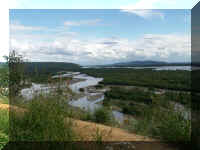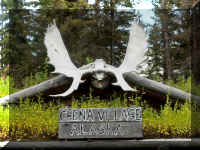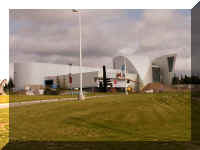

Tok to Fairbanks - Alaska 2005
Updated: 11/30/08
The road out of Tok was very smooth. The problem was not with the road but that the fog blocked our view of the Alaska Range of mountains. But, every once in a while, a peak would appear through the clouds.
Approaching Delta Junction we crossed Gerstle River, a very interesting place. It was almost dry with 'streams' of water weaving their way through. There was a parking area down by the river so we drove down to walk in the river. From the vehicle tracks, it was evident that people drove on the river bed.
This moose and her baby were eating grass along the tree edge. The mom did not spook as fast as her baby. But, they were both gone very quickly. Because the baby is difficult to see, we have helped you a little. With the sun in your face, it is difficult see through the camera viewer.
 The
Alaska Highway ends at Delta Junction - Mile 1422. We are now the proud possessors
of a certificate that we traveled the entire Alaska Highway.
The
Alaska Highway ends at Delta Junction - Mile 1422. We are now the proud possessors
of a certificate that we traveled the entire Alaska Highway.
It is signed by the hostess of the tourist information center for authenticity. Oh yes, it costs one dollar.
 This mile post indicates the spot where the
Alaska Highway ends - at the Richardson Highway. It is the Richardson Highway that
goes to Fairbanks.
This mile post indicates the spot where the
Alaska Highway ends - at the Richardson Highway. It is the Richardson Highway that
goes to Fairbanks.


Not
too far north of town is this lush area - so different
from the dry river south of town.
 Rika's
Roadhouse is in Big Delta State Historical Park just nine miles north of Delta
Junction. Admission is free and you can
roam the grounds as long as you wish. We were there a little over an hour.
Rika's
Roadhouse is in Big Delta State Historical Park just nine miles north of Delta
Junction. Admission is free and you can
roam the grounds as long as you wish. We were there a little over an hour.
This is what a typical room travelers used would look like in the roadhouse. It was complete with a small tub in the corner.
This picture on the wall showed
the ingenuity of the people.
This old MilePost magazine was on display. There are times we think the information is unchanged from this 1971 issue. Some of the 'scenic' pull-offs indicated in our current issue are surrounded by trees blocking our view.
From the grounds of Rika's Roadhouse we got our fist glimpse of the Trans-Alaska Pipeline. These photographs were made a little farther down the road. There, at a local boat landing, we could get close to where the pipeline crossed the Tanana River.
The Eielson Air Force base is just outside North Pole, Alaska. We watched this jet land beside us and the four other jets had their light flashing ready to takeoff.
 North
Pole, Alaska is where Santa Claus lives. The town is decorated for the spirit -
some streets have banners and some street light poles look like candy canes.
North
Pole, Alaska is where Santa Claus lives. The town is decorated for the spirit -
some streets have banners and some street light poles look like candy canes.
 And,
we can't forget the 'real' North Pole.
And,
we can't forget the 'real' North Pole.
 We
took the opportunity while we were in town to become North Pole, Alaska property
owners. It is a small plot of land but we can say we own part of Alaska.
We
took the opportunity while we were in town to become North Pole, Alaska property
owners. It is a small plot of land but we can say we own part of Alaska.
After spending a little time and some money in North Pole, we continued our drive to Fairbanks. We have found that the horror stories about the roads in Alaska related to the less traveled roads. You do have to be alert for bad patches ... but ... generally they are very good. The ride to Fairbanks was on four lane divided highway.
 There
must be an airport close to the Richardson Highway. This airplane missed
the runway.
There
must be an airport close to the Richardson Highway. This airplane missed
the runway.
 Our
first order of business was to find a locksmith - we needed a key made. So,
where do you go with questions, Wal-Mart. As we were standing at the customer
service desk looking through the yellow
pages, a department manager approached and asked it he could help. He did and
before we left we asked if you could spend the night in their parking lot. He
said, No. There is a city ordinance against it. He said we could leave the HHII there,
however, so
we did not have to tow it to the locksmith. As we were about to unhitch, he
drove up and said he forgot to ask where we were from. As we talked, we noticed
almost 30 RV parked in a vacant lot next to Wal-Mart. He claimed not to know
about them. We went over there and found people who had been there for four
nights and no one hassled them. So, we unhitched and left the HHII there for the day and
spent the night there.
About 12:30am, Fred saw two guys putting this notice on all the RVs. Timing is
everything! We dry camped in the city 'camp lot' for the remainder of our stay
in Fairbanks.
Our
first order of business was to find a locksmith - we needed a key made. So,
where do you go with questions, Wal-Mart. As we were standing at the customer
service desk looking through the yellow
pages, a department manager approached and asked it he could help. He did and
before we left we asked if you could spend the night in their parking lot. He
said, No. There is a city ordinance against it. He said we could leave the HHII there,
however, so
we did not have to tow it to the locksmith. As we were about to unhitch, he
drove up and said he forgot to ask where we were from. As we talked, we noticed
almost 30 RV parked in a vacant lot next to Wal-Mart. He claimed not to know
about them. We went over there and found people who had been there for four
nights and no one hassled them. So, we unhitched and left the HHII there for the day and
spent the night there.
About 12:30am, Fred saw two guys putting this notice on all the RVs. Timing is
everything! We dry camped in the city 'camp lot' for the remainder of our stay
in Fairbanks.
At 2:00am, this is darkness in Fairbanks. You can tell because the parking lot lights are on. Sunrise was at 3:26am.
 Because
Wal-Mart was our first stop, that is where we saw the first parking lot electrical
receptacles for
vehicle engine block heaters. Later we saw them all over town for employee
vehicles while they are at work. With the engine warm, they are assured of a
start after the workday is done on a minus 22 degree day.
Because
Wal-Mart was our first stop, that is where we saw the first parking lot electrical
receptacles for
vehicle engine block heaters. Later we saw them all over town for employee
vehicles while they are at work. With the engine warm, they are assured of a
start after the workday is done on a minus 22 degree day.
As we left the locksmith, Fred noticed this sign on the building across the street.
We shared one when we got home.
The University of Alaska - Fairbanks provides a large animal research program.
 The
most cooperative animal was the Muskox. He really wasn't cooperative, he was
hungry. As soon as they put hay out for him, he wandered out of the woods.
The
most cooperative animal was the Muskox. He really wasn't cooperative, he was
hungry. As soon as they put hay out for him, he wandered out of the woods.
 They
display other animals but we did not pay the $6.00 fee to tour the grounds. The
Muskox was so handsome we did not want to see others.
They
display other animals but we did not pay the $6.00 fee to tour the grounds. The
Muskox was so handsome we did not want to see others.
 We took a boat ride on the Chena River. The boat was a authentic
sternwheeler called the Voyager III. The family that runs the attraction
Riverboat Discovery has a history with steam ships going back generations. They did a good job of presenting the
history of the area at stops along the river. Tickets are about $45.00 per
person for the 3.5 hour cruise. It is a very interesting time. (The family also
operates the El Dorado Gold Mine attraction which we did not visit.)
We took a boat ride on the Chena River. The boat was a authentic
sternwheeler called the Voyager III. The family that runs the attraction
Riverboat Discovery has a history with steam ships going back generations. They did a good job of presenting the
history of the area at stops along the river. Tickets are about $45.00 per
person for the 3.5 hour cruise. It is a very interesting time. (The family also
operates the El Dorado Gold Mine attraction which we did not visit.) 
This is Discovery I, their first boat.


The buildings house a gift shop. The floating dry dock was made from
excess pipeline pipe sold as salvage. He wanted 1200 feet, they forced
him to buy the 6000 foot lot. Later, when they wanted to buy back a little
to make repairs, he made a lot of money selling back the extra 4800 feet.
The ride on the river starts with a bush pilot landing and taking off for the crowd.
 This airstrip is used when conditions are not good on
the river. The air strip was built for personal use but became popular with
local bush pilots so it became a commercial venture.
This airstrip is used when conditions are not good on
the river. The air strip was built for personal use but became popular with
local bush pilots so it became a commercial venture.
As you cruise the Chena River the narrator gives information on many points of interest. Of course, along the river you know the history of each property and each owner of that property. President Reagan stay in this brown house. This barge was used in a campaign for governor of Alaska.
At one point, "the wedding of the rivers", the clear-water Chena River flows into the glacial-fed Tanana River.
As we approach the Tanana River above, we come upon a herd of reindeer. They had the points of interest very well organized and all are 'wired' for sound to the boat's sound system so everyone can hear the people on shore talk. Some on the people then have to race down the river by motor boat to the Chena Indian Village to give another presentation.
 The information about sled dogs presented by Iditarod Champion
Susan Butcher was very informative. Her kennel was a long stop for
the boat. Susan did not go to the village but her husband (Dave Monson, also a
champion trail musher) took his boat to the village to present more information
on sled dogs.
The information about sled dogs presented by Iditarod Champion
Susan Butcher was very informative. Her kennel was a long stop for
the boat. Susan did not go to the village but her husband (Dave Monson, also a
champion trail musher) took his boat to the village to present more information
on sled dogs.
She raced her 'sled' around the small lake on her property. If you look closely at the first frame, you will see the dogs jumping with excitement as they are attached to the rope. In the fourth frame, on the "stop" command, they are frozen in place.
The exercise wheel can be seen below and the kennels in frame three above.
 This is Athabascan Dixie Alexander who has displays
of her native beadwork in the Smithsonian Museum. She was demonstrating how a
native fish camp would operate along the river. She later was part
of the presentation on native dress at the village.
This is Athabascan Dixie Alexander who has displays
of her native beadwork in the Smithsonian Museum. She was demonstrating how a
native fish camp would operate along the river. She later was part
of the presentation on native dress at the village. 

Currently, the use of fish ladders is restricted because they are so efficient.
 After
passing the "marriage of two rivers", we went to the Chena Indian
Village.
After
passing the "marriage of two rivers", we went to the Chena Indian
Village.


The smoke house, outside and inside.
We were at the village for presentations on sled dogs, clothing, trapping and housing.
This dog knew the routine . . . harness, windbreaker and then boots.
The clothing worn by the natives was beautiful.
Trapping was the main source of income. A house made of tree bark.
After the boat tour, we went to the Pump House restaurant for dinner. It is an authentic tin pump house used in mining operations. The restaurant is listed on the National Register of Historic Places. It is a place we passed on the sternwheeler. Delicious seafood chowder - we both liked it.
 We visited the University of
Alaska- Fairbanks Museum of the North. The campus is on a hill overlooking the
city. They had displays for all the regions of Alaska. A video presented the
impact the WWII and the years in the 1940s had on the Aleutian Island natives.
We have posted some of the photographs made at the museum.
We visited the University of
Alaska- Fairbanks Museum of the North. The campus is on a hill overlooking the
city. They had displays for all the regions of Alaska. A video presented the
impact the WWII and the years in the 1940s had on the Aleutian Island natives.
We have posted some of the photographs made at the museum.

 Bones and fishing methods . . .
Bones and fishing methods . . .
 A car handmade by a Fairbanks resident . . .
A car handmade by a Fairbanks resident . . .
Our last day in Fairbanks . . . we thought we should drive through the downtown. We had shopped and spend our time on the outskirts previously. They have a nice city park along the river. It seemed to be frequented by a lot of people, including many having lunch.
It has rained a little or a lot every day we have been in
Fairbanks.
Today, we saw a rainbow.
Go back to Alaska Photo Album .